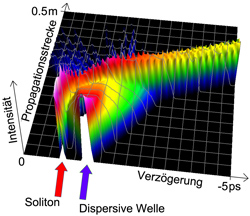Researchers from the Leibniz University Hannover, the Weierstraß Institute for Applied Analysis and Stochastics as well as the Max Born Institute for Nonlinear Optics and Short Pulse Spectroscopy have developed a new concept to generate optical white-light pulses in the visible and near infrared. These pulses can be compressed to extremely short pulse duration, comprising only a single oscillation of the optical carrier field.
The generation of broadband whitelight supercontinua from spectrally narrow input laser light is one of the most fascinating processes in Nonlinear Optics and found many applications in spectroscopy, metrology and biomedical imaging. Despite of rather modest average output powers, the source area of fiber-based whitelight sources is extremely small, and they exhibit excellent spatial coherence properties like a laser. These favorable properties make fiber-based supercontinua a million times brighter than the sun.
However, the spectral coherence of such white-light sources is much poorer than the spatial one. While the light can be spatially refocused into a small spot, a similar concentration of energy along the temporal coordinate is typically impossible. In the current issue of Physical Review Letters [PRL 110, 233901 (2013)], Ayhan Demircan, Shalva Amiranashvili, Carsten Brée, and Günter Steinmeyer propose a novel method to circumvent this limiting problem of white-light sources. Rather than only launching light at one narrow wavelength region into the fiber, they demonstrate that a carefully selected combination of two pulses at well-separated wavelengths gives rise to fully compressible white light generation inside the same type of nonlinear optical fiber. The trick is to launch both pulses at nearly identical velocities, like a surfer catching a wave, to the end of inescapably locking both components together. The nonlinear interaction within this two-color optical pulse then quickly fills the spectral gap in between with newly generated coherent radiation, giving rise to coherent white light generation that can be recompressed into a short pulse.
The simulations indicate that it should be possible to directly generate optical pulses that only comprise two optical cycles of the carrier wave. Additionally, using linear dispersion compensation, even synthesis of single-cycle optical pulse should be possible. In contrast to previous methods, the resulting spectra are relatively smooth, which opens new applications, e.g., for biomedical imaging. In conclusion, the novel two-pulse white-light generation enables a wealth of previously impossible applications for these fascinating bright light sources.
Fig. 1: Numerical simulations of two-color excitation of white-light generation in a fiber. Two pulses, namely a soliton in the anomalous dispersion region and a dispersive wave in the normal dispersion region are launched at a slight delay into a fiber. While the soliton initially maintains its pulse shape, the dispersive wave quickly spreads out in time. Once both pulses start to interact, both pulse remain locked to each other and start to heavily interact with each other. Only a marginal part of the dispersive way can actually penetrate the barrier imposed by the soliton.
Contact:
| Max-Born-Institut für Nichtlineare Optik und Kurzzeitspektroskopie Günter Steinmeyer, Tel: +49-30-6392 1440 |


